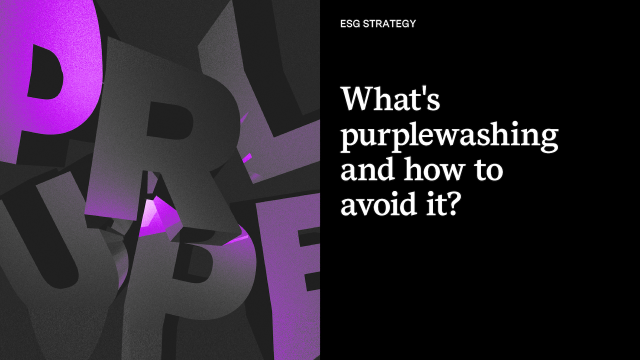
Purplewashing: what is it and how to avoid it?

At Republik, our mission is to avoid the pitfalls of sensationalism at all costs. There are many of these pitfalls, all harmful to the proper understanding of an issue: distorting or oversimplifying a complex problem, perpetuating harmful or stereotypical representations, contributing to the stigmatization or discrimination of certain groups, and the list goes on. As a multidisciplinary team motivated to change things for the better, it is unthinkable to create without considering a well-thought-out strategy, the parameters of our clientele, but especially the world around us. To avoid falling into the traps of sensationalism, it is therefore essential to create inclusively in our writings, productions, photo sessions, and in choosing our business partners. But, what is inclusive creativity?
Inclusive creativity is an approach that involves and benefits a diverse range of people. It is a concept that emphasizes the importance of creating environments, processes, and products that are accessible and welcoming to people with different perspectives, experiences, and skills. Inclusive creativity recognizes that diversity enhances the creative process, leads to more comprehensive and meaningful solutions, and allows a message to resonate with a broader audience. This approach often requires breaking down barriers that might exclude certain individuals and invites us to actively seek the input of people from various backgrounds.
Beyond gender-neutral writing and representing different communities, inclusive creativity is an approach that demonstrates the necessary sensitivity to address complex issues without falling into the traps of opportunism or sensationalism. Mélodie Karama, creative director at Republik, recently presented two case studies that concretely demonstrate various solutions for creating inclusively at the Equity, Diversity, and Inclusion Summit 2024 by Infopresse, which we present here.
Finding Support to Find a Way Out | Fonds de solidarité FTQ At first, the Fonds de solidarité FTQ tasked our team with building an awareness campaign that was supposed to highlight a significant donation made by the organization towards women’s shelters. We saw a risk of opportunism since the Fonds de solidarité FTQ would have been more highlighted than the education or awareness of the cause itself. To avoid this trap, we reframed the mandate to make it a strong awareness campaign, aiming to highlight testimonials from survivors of domestic violence against women.
To do this, we consulted with survivors of domestic violence and shelter workers to gather their opinions and make the required changes to the campaign based on their feedback. You'll understand: it was necessary to show great empathy and create the safest possible framework. Our priority was to make women comfortable as they shared their extremely difficult and vulnerable stories.
We also had to ensure the anonymity of the people interviewed at all costs: that's why hiring actresses who could represent the survivors’ stories visually, and using voice-modification software, were essential to the successful realization of these videos.
Finally, as the crucial point was to make the survivors as comfortable as possible in a situation of vulnerability, we worked with a team composed mostly of women, from direction to creation and production.
Result? A touching awareness campaign, made with complete and total respect for survivors of domestic violence.
Tout le monde a des bas | Université de Montréal (UdeM) When exchanging ideas for this awareness campaign for UdeM, the French play on words “On a tous des bas” came up a lot. However, it was essential that this slogan be gender-neutral to unite the entire university community around the same issue. Solution: “Tout le monde a des bas”, which speaks to everyone and clearly insinuates the topic of mental health.
Next, to represent all members of a university, but especially to undo the pejorative association between the young student population and mental health, we wanted to highlight testimonials that represent three audiences: this same student pool, the faculty, and the administrative staff. We wanted to break down stereotypes across all target audiences and thus demonstrate that no one is immune to mental health issues, regardless of age, position, gender, or any other characteristic.
We also featured people from diverse backgrounds to demonstrate the impact of racism on mental health through testimonial videos. It was important to remind viewers that not everyone shares the same reality by recalling the intersectionality of issues. Yes, it is good to try to put everyone on an equal footing, but each person has their own unique background, which can vary depending on age, gender, social environment, family history, sexual orientation, etc.
In the end, the biggest challenge was to demystify issues of varying complexities to raise awareness among both well-informed people and those just beginning to open up to the subject. With a landing page named after the campaign, everyone has access to professional information and external resources if needed.
Result? A campaign that speaks to everyone thanks to gender-neutral writing, the representation of visible minorities, tools that address all levels, and a range of ages and profiles highlighted.
Finally, the benefits of inclusive creativity are numerous and easily recognizable. It allows us to avoid many pitfalls of sensationalism by demonstrating our ability to handle sensitive topics, deconstructing extremes, stereotypes, and biases, fostering empathy and understanding, creating bonds of trust with marginalized groups, and much more. Our multidisciplinary team, always motivated to generate a positive long-term impact, takes into account all realities in order to create inclusive initiatives that are carriers of conviction, conversation, and change.